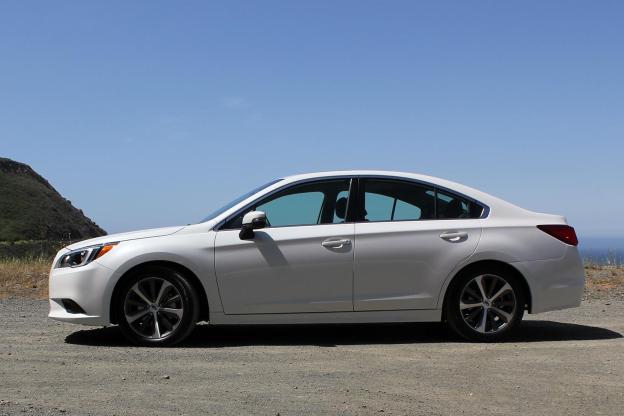Most midsize sedans are so dull that they make you consider self-harm, The Subaru Legacy, however, thanks to fresh styling and a WRX inspired drivetrain is special. It’s a family car with a pulse.
If the intentions of Subaru’s press team in letting journalists bring their significant others along to test the new Legacy was to create ‘real world’ driving situations; then they succeeded. No more than five minutes after stepping into the brand new 2015 Legacy outside the Monterrey airport, a small explosion and a barrage of un-lady like language emanated from the Legacy’s passenger seat.
As we settled into the car, my wife decided to touch up her makeup. Apparently, however, the jostling of the flight caused the seals on both a container of makeup remover and a tube of mascara to break, causing the products to run everywhere when opened.
In other cars, this might have been a problem. But Subarus are built to withstand the rigors of an active family. So by the time we arrived at our hotel, the interior was unmarked.
Durability, however, is only half the Legacy story, when it comes to the all-new Subaru Legacy. The next day we took Subaru’s latest family sedan out on the Pacific Coast Highway (PCH) – one of the best roads in the world. There we found the real reason to love this car.
Hitting the road
In most midsize sedans, the driving experience is an afterthought. It often seems drivability is just something to address after dealing with the important stuff like door trim and child seat latches. That attitude doesn’t really hold up on the PCH, where tight hairpins and long sweepers are guarded on one-side by rocky cliff walls and on the other by sheer drops to the gorgeous but cold Pacific.

Thankfully, when Subaru designed the new Legacy, it had a pretty extensive toy box to play with. Not only does the new Legacy get Subaru’s excellent symmetrical all-wheel drive, it also gets a very exciting party-piece: torque vectoring from the new 2015 WRX.
This came in handy when the head of Subaru PR came barreling up behind me in a candy red WRX STI. Not wanting to let him down, I stomped down on the gas pedal and tried to hang with the road-going rally car.
The Legacy might be big and heavy, but it feels nimble and precise. The steering – thanks to its rack-mounted electrical assist – is communicative and precise.
This is a feature that comes in handy when taking a turn hard enough to cause the torque vectoring to take over. The torque vectoring system uses the brakes to stab at the inside wheels in a corner, helping the Legacy keep its correct cornering line.
As I hammered along the PCH trying to stay ahead of that angry-looking STI in my rearview mirror and out of the ocean, I could feel the car pull itself towards apexes, literally fighting physics.
When combined with the glue-like traction of the all wheel drive, this is a family sedan that feels like a rally car that can keep up with a WRX STI … as long as the STI’s driver is a PR person trying not to embarrass you.
Poooooooowwwwer?
The Legacy might have the suspension and traction to behave like a WRC rally car, but with basically same go-boxes as the previous Legacy, it isn’t quite a sports car.
The base engine is a heavily redesigned version of Subaru’s 2.5-Liter BOXER four-Cylinder. With 175 horsepower and 174 pound-feet of torque. This engine is adequate, but has its work cut out for it when hauling around 3,500 pounds of Legacy. However, it is at least good for a very competitive 29 mpg.

The 3.6-Liter BOXER six-cylinder is a much better option, if going fast is required. Its 256 hp and 247 torques take much better advantage of the Continuously Variable Transmission. Also, compared to the harsh buzz of its four-cylinder cousin, the BOXER-six gives off a pleasant growl.
Practical, tough, and now well equipped
The Achilles heel of past Subaru has been its infotainment systems, which have been – frankly – embarrassing. The new Legacy goes into battle with a new and massively improved system.
With a starting price of $22,490, this is a seriously inexpensive car.
But as I said at the start, the Subaru Legacy is made by its toughness and versatility. The car is huge on the inside with a capacious trunk.
Some of the trim feels a bit cheap, and in the lower level cars there is an unpleasant amount of road noise. But with a starting price of $22,490, this is a seriously inexpensive car. And, despite occasionally feeling a bit too budget minded, the car gives a sense of makeup, kid, and pet-proof toughness.
Midsize with an oversize personality
The biggest problem with most midsize cars is not that they are bad; but that they are so mind-bendingly dull that you want to jam a fork in your leg after an hour of driving them.
The 2015 Subaru Legacy might check all the same practical boxes as its competitors but – delightfully – it is still exciting. Even my normally sensible wife got over her frustration with the makeup and drove the car like she was in a race. She even got exorcised enough to curse at Prius drivers for going under the speed limit.
I couldn’t be prouder of her, or happier with the 2015 Subaru Legacy.
Highs
- Subaru’s Symmetrical All-Wheel Drive
- WRX sourced Torque Vectoring
- Capacious and rugged interior
- New Infotainment system
Lows
- Barely adequate power from entry-level engine
- Excessive road noise




